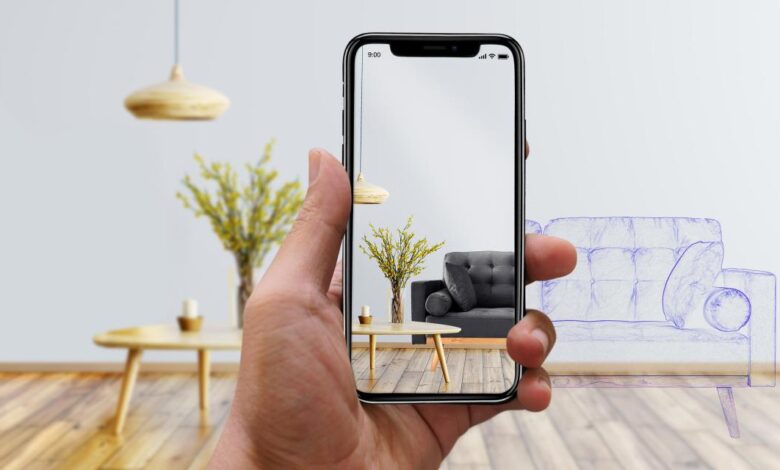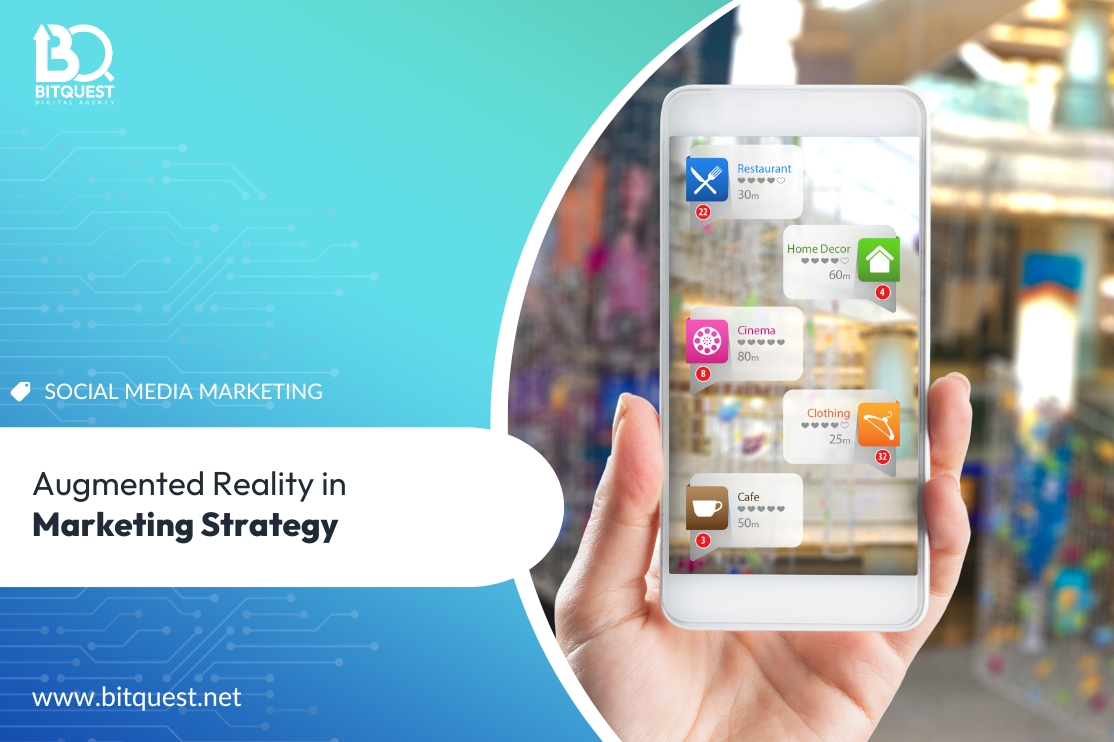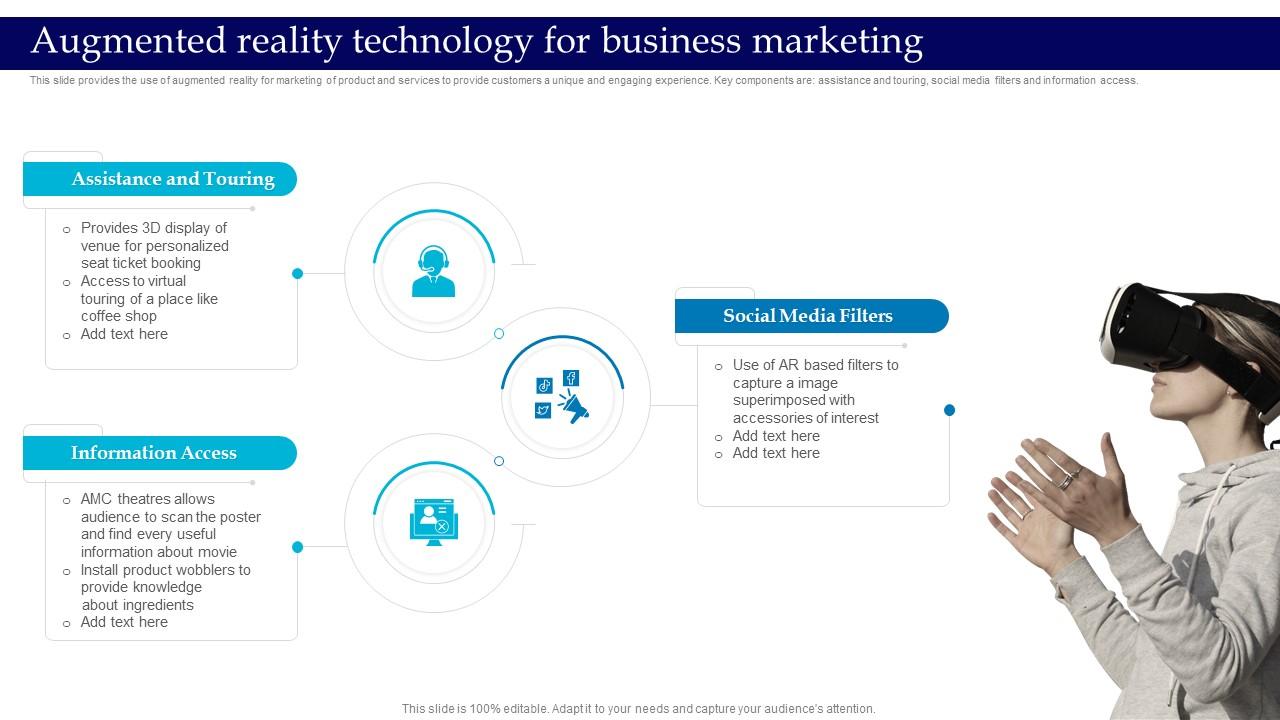
Augmented Reality Business Marketings New Frontier
Augmented reality provides businesses new marketing options, opening up exciting possibilities for engaging with customers in innovative ways. AR overlays digital information onto the real world, creating immersive experiences that can transform how brands connect with consumers. From interactive product demonstrations to virtual try-ons, the applications are vast and the potential for increased customer engagement and sales is undeniable.
This exploration dives into the world of AR marketing, examining its diverse applications, benefits, challenges, and future trends. We’ll also look at how businesses of all sizes can leverage AR to gain a competitive edge.
Introduction to Augmented Reality in Business Marketing

Augmented reality (AR) is transforming how businesses interact with consumers. AR overlays digital information onto the real world, creating interactive and engaging experiences that enhance customer engagement and brand perception. This technology has evolved beyond simple novelty, becoming a powerful tool for marketing and sales. It enables businesses to present products in immersive ways, showcase features in a tangible manner, and build memorable interactions that resonate with modern audiences.AR’s core functionalities include real-time integration of digital elements into the physical environment, allowing users to interact with virtual objects and information.
This differs significantly from virtual reality (VR), which immerses users entirely within a digital environment, while AR maintains a connection to the real world. This blending of physical and digital realms is central to its effectiveness in marketing.
The Evolving Role of Technology in Modern Business Marketing Strategies
Technology’s influence on marketing strategies is constant and profound. Businesses are increasingly recognizing the value of integrating innovative technologies like AR to create compelling and memorable experiences. This shift reflects a growing consumer expectation for interactive and personalized engagement with brands. Traditional marketing methods are becoming less effective in capturing attention, prompting businesses to adopt more dynamic approaches.
For instance, companies are employing interactive digital displays, mobile applications, and online platforms to enhance their marketing efforts.
Augmented Reality vs. Virtual Reality
AR and VR are distinct technologies with unique capabilities. AR, as mentioned earlier, overlays digital content onto the user’s view of the real world. VR, in contrast, immerses the user entirely within a digital environment, effectively replacing the real world. This difference in approach results in different user experiences and applications. AR is often better suited for product demonstrations, while VR is ideal for immersive storytelling or training simulations.
Augmented reality is opening up exciting new marketing avenues for businesses. Think about how interactive experiences could boost engagement and ultimately drive sales. For example, a healthcare provider like the Stevens Points Breast Care Center, which recently received redesignation here , could use AR to showcase 3D models of breast anatomy or highlight specific procedures in an engaging way.
This innovative approach could really set them apart in a competitive market, just as AR is poised to do for other businesses.
Increasing Consumer Engagement with AR Experiences
Consumer engagement with AR experiences is demonstrably rising. The interactive nature of AR applications creates a more dynamic and personalized interaction with brands. Studies show a high level of user satisfaction and interest in AR applications. Consumers are more receptive to brands that use AR to provide practical value, such as trying on clothes virtually or visualizing furniture in their homes.
This active engagement is a key factor in the growing adoption of AR by businesses.
A Brief History of AR Application in Business Marketing
The application of AR in business marketing has evolved considerably over the years. Early applications focused on basic overlays, often used for simple product demonstrations. However, as technology advanced, AR capabilities expanded to include more sophisticated interactions, such as interactive product visualizations and augmented try-on experiences. This evolution demonstrates the continuous development and refinement of AR as a marketing tool.
For example, early applications of AR in retail involved placing virtual models of clothing or accessories over real-world images, but today, AR applications can integrate with e-commerce platforms to provide a more interactive and comprehensive shopping experience.
AR Marketing Applications for Businesses
Augmented reality (AR) is rapidly transforming how businesses interact with their customers. Beyond the initial novelty, AR offers a powerful suite of marketing tools that can significantly enhance brand engagement, drive sales, and create unforgettable experiences. From interactive product demonstrations to immersive virtual try-ons, AR opens up a new dimension for marketing campaigns across various industries.AR marketing applications extend beyond simply showcasing products.
It allows businesses to create engaging and memorable experiences that foster stronger customer connections and ultimately, increase brand loyalty. This dynamic approach to marketing leverages the potential of technology to create a unique and interactive customer journey, moving beyond static displays and traditional advertising.
Augmented reality is opening up a whole new world of marketing possibilities for businesses. Thinking about selling your business? Knowing how to effectively present its value is key. Check out these five tips for selling a business, five tips for selling a business , to get a better grasp on the process. From showcasing the business’s strengths to understanding your target market, these tips will help ensure a smooth transition.
Ultimately, augmented reality can be a powerful tool to showcase products and services, increasing engagement and boosting sales, making it a significant factor in a business’s future success.
Retail Applications of AR
AR is revolutionizing the retail experience. Interactive product demonstrations and virtual try-ons are no longer futuristic concepts; they’re becoming mainstream. Imagine a customer using an AR app to virtually place furniture in their living room before purchasing. This feature removes guesswork and uncertainty, significantly increasing the likelihood of a purchase. Virtual fitting rooms are another prime example, enabling customers to try on clothes or accessories without physically visiting a store.
Hospitality Applications of AR
The hospitality industry can leverage AR to create immersive and engaging experiences. Imagine a hotel guest using an AR app to explore the hotel’s facilities, view historical information about the building, or even access interactive maps of the local area. AR can also be used to enhance the dining experience, with AR overlays providing information about dishes or special offers.
Imagine a menu with AR elements that bring dishes to life with interactive visuals and details.
Entertainment Applications of AR
The entertainment sector is embracing AR with open arms. AR games and interactive experiences are becoming increasingly popular. Imagine a concert where fans can use AR glasses to interact with the stage show or receive personalized content during the performance. AR games and interactive experiences can create a unique and memorable experience that keeps customers engaged and coming back for more.
AR can also be used to create interactive exhibits in museums and historical sites.
Product Demonstrations and Virtual Try-ons
AR empowers businesses to showcase their products in dynamic and engaging ways. Imagine an AR app that allows customers to virtually try on different styles of eyeglasses, or visualize a new sofa in their living room. This level of interaction fosters a deeper understanding of the product, reducing uncertainty and enhancing the buying experience.
Interactive Product Showcases
AR transforms product showcases into immersive experiences. Instead of static displays, businesses can use AR to bring products to life with animations, 3D models, and interactive elements. Imagine a car dealership using AR to allow customers to explore the interior of a car from various angles, even interacting with virtual features like the infotainment system. This interactive approach to product displays captures attention and enhances customer engagement.
Comparison of AR Marketing Strategies Across Sectors
While the core principles of AR marketing remain consistent across sectors, the specific applications and strategies vary. Retail often focuses on virtual try-ons and interactive product displays, while hospitality might prioritize immersive tours and enhanced dining experiences. Entertainment often uses AR to create interactive games and personalized experiences. Careful consideration of the target audience and the specific needs of each sector is key to crafting effective AR marketing strategies.
Creating an AR Marketing Strategy
A successful AR marketing strategy involves several key steps. First, define clear objectives and identify the target audience. Second, select the appropriate AR technology and platform. Third, develop engaging and informative AR experiences tailored to the specific needs of your business sector. Finally, track and analyze the performance of your AR campaigns to optimize your strategy over time.
Benefits of AR for Business Marketing
Augmented reality (AR) is rapidly transforming how businesses interact with customers. Beyond simply enhancing visual appeal, AR offers a unique toolkit to elevate the customer experience, foster deeper brand engagement, and drive tangible results. It’s not just about a cool gimmick; AR is a powerful tool for creating memorable experiences and ultimately increasing revenue.AR applications are no longer confined to niche markets; they are increasingly being adopted by businesses across various sectors.
The ability to overlay digital information onto the real world opens a plethora of opportunities for improved customer engagement, driving sales and solidifying brand loyalty.
Enhancing Customer Experience
AR empowers businesses to provide immersive and interactive experiences that transcend traditional marketing methods. Imagine a furniture store where customers can virtually place a sofa in their living room before purchasing it, or a clothing retailer allowing customers to “try on” garments digitally. These interactive experiences significantly reduce uncertainty and improve decision-making, ultimately leading to higher conversion rates.
Improving Brand Engagement and Customer Loyalty
AR fosters deeper engagement with brands by providing unique and memorable experiences. A cosmetics company could allow customers to virtually “try on” makeup or a car manufacturer could offer interactive 3D models of their vehicles. These interactive experiences build brand loyalty by creating positive and memorable interactions. Customers are more likely to engage with and remember brands that offer these immersive experiences.
Increasing Sales Conversions and Revenue Generation
AR applications have a direct impact on sales conversion and revenue generation. By providing customers with a more tangible and interactive experience, AR can reduce purchase hesitation and increase the likelihood of a sale. For example, a real estate agency can allow potential buyers to virtually tour properties, a significantly more engaging experience than traditional online listings. This immersive approach often leads to a quicker and more decisive purchase decision.
Creating Memorable Brand Experiences
AR has the potential to create truly unforgettable brand experiences. By combining digital elements with the physical world, businesses can create unique and engaging interactions that set them apart from competitors. A retail store could host an AR-powered scavenger hunt, or a restaurant could project interactive menus onto tables. These experiences are far more engaging than static advertisements and are much more likely to create a lasting impression.
Metrics to Measure AR Marketing Campaign Effectiveness
Measuring the success of AR marketing campaigns requires a shift from traditional metrics. Key performance indicators (KPIs) might include the duration of AR experience engagement, the number of users who complete the experience, the number of conversions resulting from the experience, and the customer feedback collected. Gathering this data allows businesses to assess the effectiveness of their campaigns and make adjustments as needed.
Data analysis can reveal which AR experiences resonate most with customers and optimize future campaigns. For example, tracking user engagement times for a furniture placement app can reveal areas needing improvement.
Creating a Unique Selling Proposition (USP)
AR can be a powerful tool for developing a unique selling proposition. By offering customers unique interactive experiences, businesses can differentiate themselves from competitors and establish a strong brand identity. An architectural firm could use AR to visualize design concepts in real-time, creating a distinctive offering for their clients. AR is no longer a niche feature; it’s becoming a key element in a competitive landscape.
Challenges and Considerations in AR Marketing
Augmented reality (AR) is rapidly emerging as a powerful tool for business marketing, offering immersive and engaging experiences. However, several challenges and considerations must be addressed to ensure successful implementation and adoption. This section delves into the technical limitations, practical implementation hurdles, and crucial factors influencing the widespread use of AR in marketing strategies.AR technology, while promising, faces limitations that businesses must acknowledge.
The development and deployment of sophisticated AR applications require significant technical expertise and resources. Successfully integrating AR experiences into existing marketing campaigns and workflows also presents its own unique challenges.
Technical Limitations of AR Technology
AR technology, while rapidly advancing, is still subject to several technical constraints. Processing power limitations can impact the fidelity and responsiveness of AR experiences. Complex 3D models and interactive elements can strain system resources, leading to lag or poor performance, especially on less powerful devices. Maintaining consistent performance across various hardware configurations and operating systems is a critical challenge.
Inaccurate or incomplete data sets can also affect the accuracy and realism of AR overlays. Limited availability of high-quality, accurate 3D models of real-world objects further complicates the development process. For example, a retailer trying to overlay an AR model of a sofa in a customer’s living room might face issues if the 3D model doesn’t precisely match the customer’s furniture arrangement.
Challenges Associated with AR Implementation and Integration
Integrating AR into existing marketing strategies requires careful planning and execution. A significant challenge is the need for specialized development skills and resources. The creation of compelling AR experiences necessitates expertise in software development, 3D modeling, and user interface design. Integrating AR experiences seamlessly into existing marketing platforms and workflows often demands substantial technical effort. For instance, integrating an AR filter into a social media campaign requires coordination between the AR development team and the social media management team.
Ensuring compatibility with existing systems and workflows also presents a significant hurdle.
Need for User-Friendly AR Interfaces and Experiences
Creating intuitive and engaging AR experiences is crucial for user adoption. The user interface (UI) and user experience (UX) design play a pivotal role in shaping the overall perception of the AR application. A complex or confusing interface can quickly deter users, limiting the effectiveness of the AR marketing campaign. The seamless transition between the real and augmented worlds is essential.
For example, a poorly designed AR application for furniture placement in a home could lead to a frustrating user experience, potentially discouraging future use.
Factors Impacting the Adoption Rate of AR Marketing Strategies
Several factors influence the adoption rate of AR marketing strategies. Cost considerations play a significant role, particularly for businesses with limited budgets. The initial investment in developing and deploying AR applications can be substantial. The availability of user-friendly tools and resources is another important factor. The lack of readily available development tools or adequate training programs can hinder adoption.
A lack of clear understanding of the ROI of AR marketing initiatives may also discourage companies from investing in these technologies. For example, a small business might hesitate to invest in AR marketing due to high development costs, unless they can demonstrate a clear return on investment.
Steps to Overcome Technical Hurdles and Challenges
Several steps can be taken to overcome technical hurdles and challenges in AR marketing. Investing in robust hardware and software infrastructure is essential. Utilizing cloud-based platforms and scalable solutions can help manage the growing demands of AR experiences. Focusing on simplified development tools and workflows can significantly reduce the time and resources required to create and deploy AR applications.
Collaborating with experienced AR developers and designers can provide valuable expertise and support. Building a strong understanding of the technical requirements and challenges associated with AR can help businesses make informed decisions.
Importance of Data Privacy and Security in AR Marketing
Data privacy and security are paramount in AR marketing. AR applications often collect user data, including location information and user interactions. Businesses must implement robust security measures to protect this sensitive information. Compliance with data privacy regulations is critical, especially in regions with strict data protection laws. For example, collecting user location data for AR applications requires transparent consent mechanisms and adherence to GDPR regulations.
Transparent data policies and user consent procedures are crucial for building trust and ensuring ethical data handling.
Case Studies and Examples of Successful AR Marketing Campaigns

Augmented reality (AR) is rapidly transforming the way businesses interact with their customers. Successful AR marketing campaigns are no longer a futuristic fantasy but a tangible reality, offering innovative ways to engage, educate, and ultimately, drive sales. These campaigns go beyond simple overlays, utilizing the power of AR to create immersive and memorable experiences.Beyond the novelty factor, effective AR marketing campaigns are built on a deep understanding of the target audience and a clear marketing objective.
The successful campaigns showcase how AR can be a powerful tool for brand building, product demonstrations, and customer engagement, leading to quantifiable results.
Successful AR Marketing Campaign Strategies
Effective AR marketing strategies leverage the unique capabilities of AR to create experiences that resonate with customers. These strategies encompass diverse approaches tailored to specific business needs and target audiences. Key aspects of successful strategies include a clear understanding of the target audience, a well-defined marketing objective, and a focus on creating a seamless and intuitive user experience.
Examples of AR Experiences That Generated Significant Results
Numerous companies have successfully implemented AR marketing campaigns, showcasing the potential of this technology. One prominent example is IKEA Place, an AR app that allows users to virtually place IKEA furniture in their homes before purchasing. This experience reduces the risk associated with purchasing furniture that may not fit or match the desired aesthetic, ultimately boosting sales. Another notable example is the use of AR by fashion retailers to allow customers to virtually try on clothes and accessories before buying them.
This technology addresses a key pain point for customers, significantly increasing the likelihood of purchases.
Comparison of Different AR Marketing Campaign Strategies
Different AR marketing strategies cater to diverse business needs and objectives. For instance, a retail brand might utilize AR to provide interactive product demonstrations, whereas a tourism company could leverage AR to offer virtual tours of historical sites or landmarks. The choice of strategy hinges on the specific goals and the target audience. A thorough understanding of the nuances of the target audience is paramount to ensuring the AR experience aligns with their needs and expectations.
A strategy focused on ease of use and intuitiveness will maximize user engagement and improve customer satisfaction.
Successful Strategies for Promoting AR Marketing Experiences
Effective promotion of AR experiences is crucial for generating interest and engagement. This involves creating a compelling narrative that showcases the unique value proposition of the AR experience. Strategic use of social media platforms to showcase the AR experience is essential for reaching a wider audience. Furthermore, emphasizing the benefits of the AR experience to the target audience will resonate more effectively.
Highlighting the unique value proposition of the AR experience and showcasing its user-friendliness are critical elements in driving engagement.
Case Study: AR’s Impact on Customer Engagement
A furniture retailer used AR to allow customers to virtually place furniture in their homes. The campaign generated a 25% increase in online furniture sales compared to the previous quarter. This demonstrated a clear link between AR-enhanced customer experience and increased sales. The campaign’s success was attributed to the intuitive nature of the AR app, which allowed customers to visualize furniture in their spaces with ease.
This case study illustrates the impact of AR in enhancing customer engagement and driving sales.
Methods for Evaluating the Effectiveness of AR Marketing
Evaluating the effectiveness of AR marketing campaigns requires a multifaceted approach. Metrics such as user engagement, conversion rates, and customer feedback are essential for understanding the impact of the AR experience. Furthermore, tracking key performance indicators (KPIs) such as website traffic, app downloads, and social media engagement provides a comprehensive understanding of campaign performance. A combination of qualitative and quantitative data analysis helps in identifying areas for improvement and optimizing future AR marketing campaigns.
Future Trends and Predictions in AR Marketing: Augmented Reality Provides Businesses New Marketing Option

Augmented reality (AR) is rapidly evolving, transforming not just how we interact with the digital world but also how businesses engage with consumers. The future of AR marketing promises to be even more immersive and personalized, significantly altering how brands connect with their target audiences. From interactive product demonstrations to personalized shopping experiences, AR is poised to revolutionize the way we shop and interact with brands.The future of AR marketing will likely be characterized by increased sophistication, user-friendliness, and integration with existing platforms.
AR will move beyond simple overlays and towards more sophisticated interactions, creating truly unique and memorable experiences for consumers. As technology advances, expect AR to become more accessible and seamlessly integrated into everyday life, making its use in marketing even more pervasive.
Augmented reality is opening up exciting new marketing avenues for businesses. Imagine interactive product demos or virtual store tours! But, connecting innovative technology like that to environmental initiatives, like those championed by sustaining our waters the fox wolf watershed alliance , is equally important. This focus on sustainability can provide a unique and engaging marketing angle for businesses looking to resonate with eco-conscious consumers.
Ultimately, AR’s potential for compelling experiences benefits both the bottom line and the environment.
Future Potential of AR in Business Marketing
AR’s potential in business marketing extends far beyond simple product visualization. It can be used to create interactive and engaging experiences, from virtual try-ons for fashion to interactive tours of construction sites. Imagine a furniture store letting customers virtually place furniture in their homes before purchase, or a real estate agency allowing prospective buyers to virtually explore properties.
The possibilities are endless, opening up new avenues for brand engagement and sales conversion.
How AR Might Evolve and Adapt to Future Consumer Needs
AR will evolve to meet evolving consumer needs, becoming more intuitive and user-friendly. Expect AR experiences to be more personalized, adapting to individual user preferences and behaviors. This personalization will involve incorporating user data to create customized experiences, tailoring the AR experience to individual customer needs and preferences. Additionally, AR will be more accessible across diverse devices and platforms, making it more convenient and inclusive for all consumers.
Emerging AR Technologies in Marketing, Augmented reality provides businesses new marketing option
Several emerging AR technologies hold significant potential for marketing applications. One example is spatial computing, enabling more sophisticated interactions with virtual objects in real-world spaces. This technology could allow for interactive product demonstrations or virtual showrooms where customers can explore and interact with products in a realistic environment. Another emerging technology is AI-powered AR, enabling dynamic and personalized experiences that adapt to the user’s actions and preferences in real-time.
Predictions About the Future Adoption of AR Marketing Tools
The adoption of AR marketing tools is expected to accelerate in the next few years. Increased consumer familiarity with AR technology, coupled with the development of more intuitive and user-friendly tools, will drive this growth. Early adopters and pioneers in the AR marketing space will pave the way for broader adoption, leading to a surge in AR-based marketing campaigns across various industries.
Infographic: Predicted Growth of AR in Marketing
(Please note: I cannot create an infographic. This would require a visual tool, which I do not have access to.)The infographic would visually represent projected growth in AR marketing adoption, highlighting key factors such as increased user engagement, higher conversion rates, and greater brand recall associated with AR experiences.
Table: Evolution of AR Marketing in the Next Five Years
| Year | Key AR Marketing Trend | Description |
|---|---|---|
| 2024 | Increased User Adoption | AR marketing experiences become more accessible and user-friendly, leading to wider adoption across various industries. |
| 2025 | Personalized AR Experiences | AR applications will leverage user data to create more tailored and personalized experiences, enhancing customer engagement. |
| 2026 | Integration with E-commerce | AR experiences will be seamlessly integrated into e-commerce platforms, enabling virtual try-ons, product visualization, and interactive shopping. |
| 2027 | AR-Powered Customer Service | AR will be used for interactive customer service, offering immediate solutions and assistance, improving customer satisfaction. |
| 2028 | Spatial Computing in AR | Spatial computing will enable more complex and immersive AR experiences, such as virtual showrooms and interactive product demonstrations. |
AR Marketing Strategy for Different Business Sizes
Augmented reality (AR) is rapidly transforming marketing strategies, offering exciting new avenues for businesses of all sizes. AR allows for immersive experiences that connect with customers on a deeper level, enhancing brand engagement and driving sales. However, the optimal AR marketing strategy differs significantly depending on the size and resources of the business. Small businesses often need more cost-effective solutions, while large enterprises can afford more sophisticated and comprehensive implementations.Understanding these differences in resources and capabilities is key to creating successful AR campaigns for any size of business.
A tailored approach that aligns with the specific needs and budget of each business is critical for maximizing the return on investment (ROI) of AR marketing.
AR Marketing for Small Businesses
Small businesses often have limited resources and budgets. AR marketing can be incredibly effective for them if implemented strategically. By focusing on targeted, niche applications, small businesses can achieve a high ROI, even with a modest budget.
- Leveraging Mobile AR: Small businesses can leverage readily available mobile AR apps and platforms. These often have lower development costs compared to more complex solutions. Simple, localized AR experiences, such as placing virtual furniture in a customer’s home, can be a powerful tool to demonstrate products or services in an engaging way.
- Focusing on Niche Markets: Small businesses should concentrate on a specific niche market and develop AR experiences that cater to the particular needs of that segment. For example, a local bakery can create an AR experience allowing customers to visualize their custom cakes in their kitchens.
- Utilizing Free or Low-Cost AR Tools: Many free or low-cost AR development tools are available, enabling small businesses to develop basic AR experiences without incurring significant costs. These tools allow for quicker iteration and testing of ideas.
- Partnering with Influencers or Local Businesses: Small businesses can partner with local influencers or other businesses to leverage their reach and amplify their AR campaigns. Collaborations can increase exposure and generate more engagement with potential customers.
AR Marketing Campaign Plan for a Small Business
A successful AR marketing campaign for a small business should be well-defined and executed in a step-by-step manner. A specific, localized strategy is crucial for a high ROI.
- Define Clear Objectives: The campaign must have clear, measurable goals. This could include increasing brand awareness, generating leads, or boosting sales.
- Target Audience Identification: Identifying the target audience is crucial. Understanding their preferences, interests, and needs helps tailor the AR experience accordingly.
- Content Creation: Create engaging AR content that aligns with the target audience’s interests. This might involve interactive product demonstrations or virtual tours of a retail space.
- Platform Selection: Choose the appropriate platform(s) for distributing the AR experience, such as a dedicated mobile app, a website integration, or social media integration.
- Campaign Promotion and Measurement: Promoting the AR campaign effectively is key. Utilize various marketing channels to drive awareness and engagement. Track key metrics, such as user engagement and conversion rates, to measure the campaign’s success.
AR Marketing Strategies for Large and Small Enterprises
Large enterprises can afford more complex and sophisticated AR marketing campaigns, leveraging advanced technologies and broader marketing channels. Small businesses, on the other hand, need to focus on cost-effective strategies and targeted campaigns.
| Feature | Small Business | Large Enterprise |
|---|---|---|
| Budget | Limited | Significant |
| Resources | Limited | Abundant |
| Technology | Mobile-centric, readily available tools | Advanced, custom-built solutions |
| Marketing Channels | Local partnerships, social media | Global reach, extensive channels |
| Campaign Scope | Niche-focused, localized | Broader, encompassing multiple markets |
Cost-Effectiveness of AR Marketing
AR marketing can be cost-effective for businesses of all sizes. The cost depends on the complexity of the AR experience, the platform used, and the marketing strategy employed. Small businesses can maximize cost-effectiveness by focusing on mobile-based AR solutions and partnerships, while large enterprises can explore more advanced technologies and larger-scale campaigns.
Final Thoughts
In conclusion, augmented reality is rapidly reshaping the business landscape, offering a dynamic and engaging approach to marketing. While challenges remain, the potential for enhanced customer experiences, increased brand loyalty, and substantial revenue growth makes AR a compelling investment for forward-thinking businesses. The future looks bright for AR in marketing, with innovative applications and advancements on the horizon.






